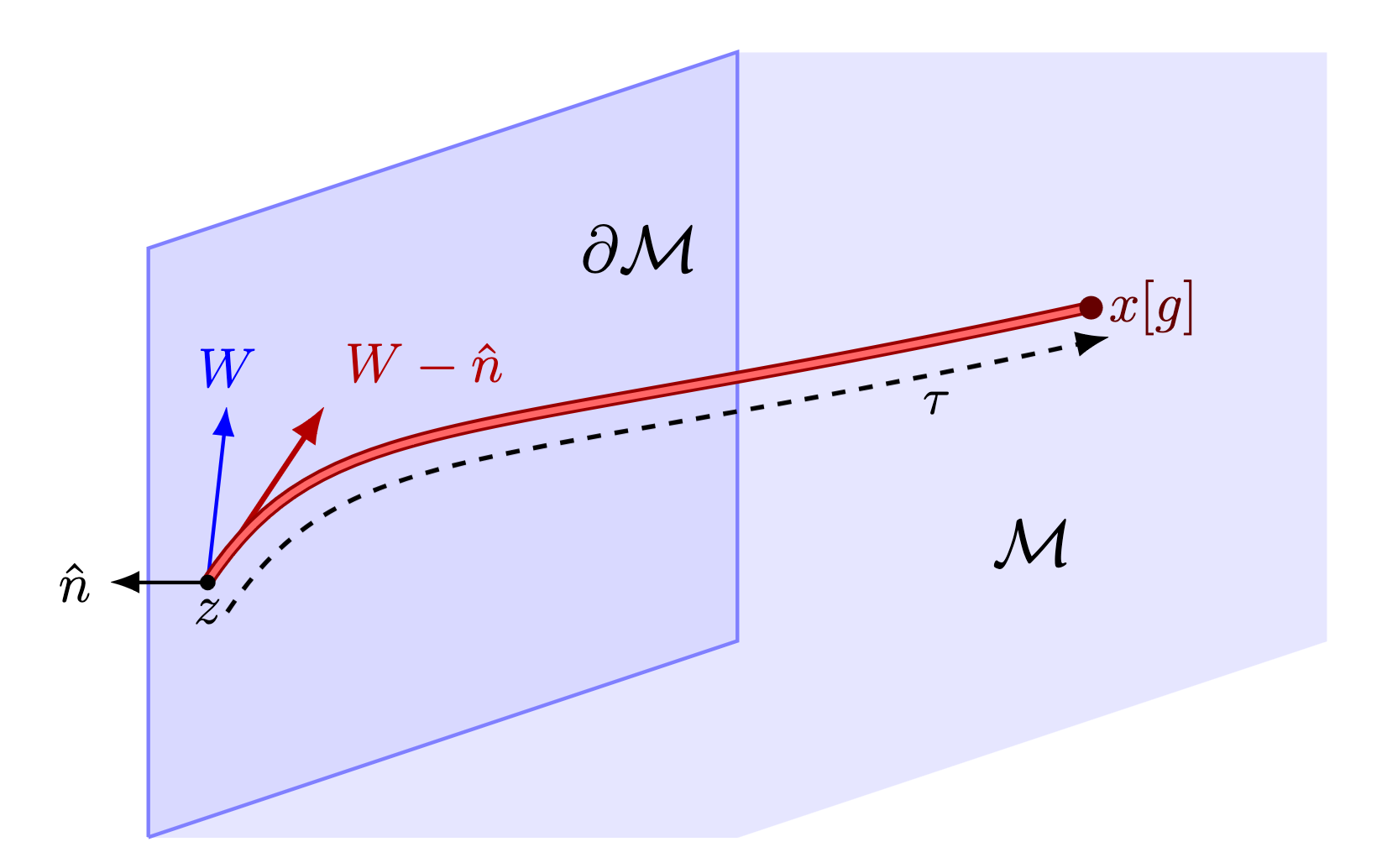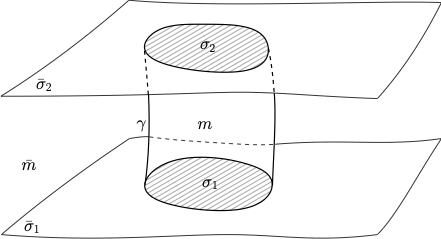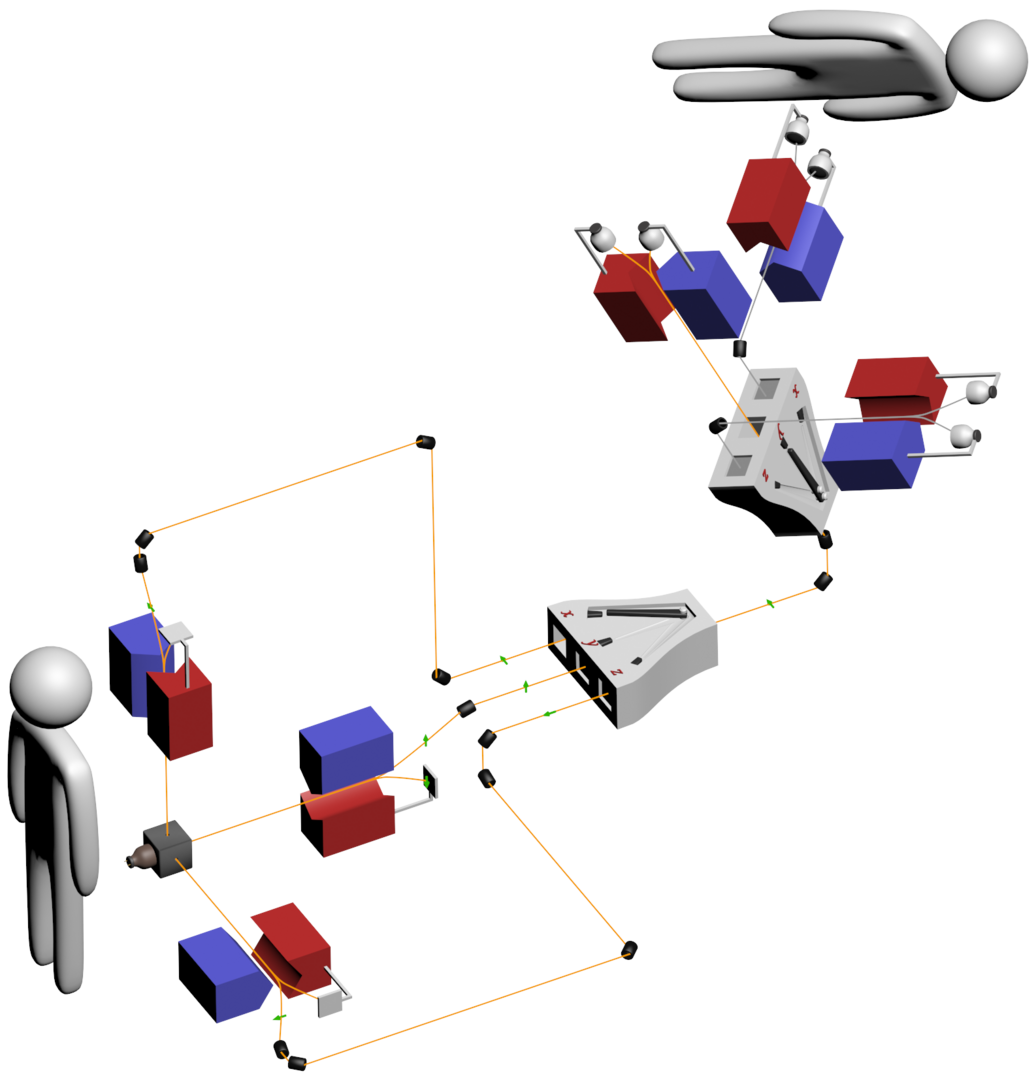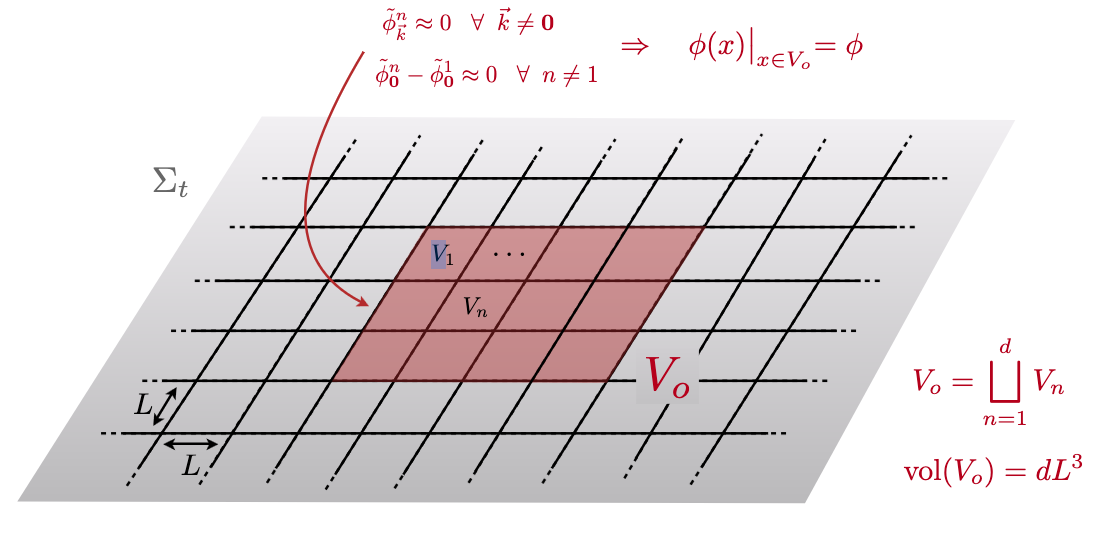FY2022 Annual Report
Qubits and Spacetime Unit
Assistant Professor Philipp Höhn
Abstract
The unit expanded in FY22 through a number of interns and our first PhD student Julian De Vuyst. Our research focus remained on further developing the notion of dynamical and quantum reference frames in gauge theory, gravity and quantum theory. In particular, we completed two long and systematic studies of the role of dynamical reference frames in generally covariant theories, elucidating their role in constructing gauge invariant observables in gravity and showing that they can be used to unify all previous approaches to gravitational observables. We also showed that edge modes and corner symmetries of finite regions in gravity can be understood in terms of dynamical frames and we developed a novel formalism for corner charge algebras. In somewhat more exploratory work we explored the operational implications of a spacetime fuzziness on reference frame synchronization between different agents. Out postdoc Josh Kirklin further established a fascinating connection between classical gauge symmetries and quantum entanglement via investigations in the classical limit of theories.
Our unit hosted the interdisciplinary workshop "Informational architecture of spacetime" in May 2022 with a number of leading researchers in quantum gravity, quantum information, foundations and many-body physics.
1. Staff
- Dr. Joshua Kirklin, Postdoctoral Scholar
- Dr. Fabio Maria Mele, Postdoctoral Scholar
- Dr. Stefan Eccles, Postdoctoral Scholar
- Julian De Vuyst, PhD student (January 2023 -)
- Dr. Isha Kotecha, Postdoctoral Scholar (- November 14th, 2022)
- Julian Lang (Rotation, AY2022 Term 1: Sept-Dec 2022)
- Saswato Sen (Rotation, AY2022 Term 1: Sept-Dec 2022)
- Mr. Giovanni Natale, Unit-funded RI (- Oct 31st, 2022)
- Mr. Victor Castillo Martinez, Unit-funded RI (- April 30th, 2022)
- Julian De Vuyst, Rotation student (AY2021 Term 2: Jan-April 2022)
- Vanessa Brzic, RI (Oct 2022 - Mar 2023)
- Germain Tobar, RI (Oct 2022 - Mar 2023)
- Midori Tanahara, Administrative Assistant
2. Collaborations
We include here only projects that involve external collaborators, but not purely internal projects.
2.1 Diffeomorphism invariant observables and dynamical frames in gravity: reconciling bulk locality with general covariance
- Description: Preprint appeared in June 2022
- Type of collaboration: Joint research
- Researchers:
- Dr. Christophe Goeller, LMU Munich
- Prof. Philipp Höhn, OIST
- Dr. Josh Kirklin, OIST
2.2 Edge modes as dynamical frames: charges from post-selection in generally covariant theories
- Description: Preprint appeared in May 2022 (still waiting for second referee report)
- Type of collaboration: Joint research
- Researchers:
- Dr. Sylvain Carrozza, IMAPP Nijmegen
- Dr. Stefan Eccles, OIST
- Prof. Philipp Höhn, OIST
2.3 On the Role of Fiducial Structures in Minisuperspace Reduction and Quantum Fluctuations in LQC
- Description: Preprint appeared in November 2022
- Type of collaboration: Joint research
- Researchers:
- Dr. Fabio Mele, OIST
- Dr. Johannes Münch, CPT Marseille
2.4 Quantum Euler angles and agency-dependent spacetime
- Description: Preprint appeared in November 2022, published in Progress of Theoretical and Experimental Physics in 2024
- Type of collaboration: Joint research
- Researchers:
- Prof. Giovanni Amelino-Camelia, U Naples
- Vittorio D'Esposito, U Naples
- Giuseppe Fabiano, U Naples
- Domenico Fratulillo, U Naples
- Prof. Philipp Höhn, OIST
- Prof. Flavio Mercato, U Burgos
2.5 Matter relative to quantum hypersurfaces
- Description: Preprint appeared in August 2023
- Type of collaboration: Joint research
- Researchers:
- Prof. Philipp Höhn, OIST
- Andrea Russo, University College London
- Prof. Alexander Smith, St. Anselm College and Dartmouth
2.6 Relational dynamics with periodic clocks
- Description: preprint to appear soon
- Type of collaboration: Joint research
- Researchers:
- Dr. Leonardo Chataignier, U Bologna
- Prof. Philipp Höhn, OIST
- Dr. Max Lock, IQOQI Vienna
- Dr. Fabio Mele, OIST
2.7 Informational complementarity identities for systems of qubits
- Description: ongoing
- Type of collaboration: Joint research
- Researchers:
- Prof. Philipp Höhn, OIST
- Giovanni Natale, OIST
- Dr. Chris Wever, Bosch Quantum Computing
2.8 Subregion relativity in gauge theory and gravity
- Description:ongoing
- Type of collaboration: Joint research
- Researchers:
- Prof. Sylvain Carrozza, U Burgogne-Dijon
- Prof. Philipp Höhn, OIST
- Dr. Josh Kirklin, OIST
- Dr. Fabio Mele, OIST
2.9 Fluctuation relations for subregions in gauge theory and gravity
- Description: ongoing
- Type of collaboration: Joint research
- Researchers:
- Prof. Sylvain Carrozza, U Burgogne-Dijon
- Dr. Stefan Eccles, OIST
- Prof. Philipp Höhn, OIST
2.10 Quantum covariant phase space
- Description: ongoing
- Type of collaboration: Joint research
- Researchers:
- Julian De Vuyst, OIST
- Prof. Philipp Höhn, OIST
- Dr. Luca Marchetti, LMU Munich
- Dr. Fabio Mele, OIST
3. Activities and Findings
We only describe activities and findings of projects completed (and published on arXiv) in FY22.
3.1 Diffeomorphism-invariant observables and dynamical frames in gravity: reconciling bulk locality with general covariance
We developed a completely general and fully non-perturbative framework for constructing dynamical reference frames in generally covariant theories, and for understanding the gauge-invariant observables that they yield. Our approach makes use of a 'universal dressing space', which contains as a subset every possible dynamical frame. We describe examples of such frames, including matter frames, a popular construction based on boundary-anchored geodesics and one using minimal surfaces -- but our formalism does not depend on the existence of a boundary. The class of observables we construct generalises and unifies the dressed and relational approaches to constructing gravitational observables, including single-integral and canonical power-series constructions. All these (possibly gravitationally charged) relational observables describe physics in a precise sense relative to the dynamical frame and respect a notion of 'relational' locality based on the relationships between fields. By using 'relational atlases', i.e. collections of dynamical frames glued together by field-dependent maps (which are relational observables too), we can construct relationally local observables throughout spacetime. This further establishes a framework for dynamical frame covariance that permits us to change between arbitrary relational frame perspectives. Relational locality obeys many desirable properties: we prove that it satisfies microcausality in the bulk (in tension with previous work done mainly in a perturbative setting which we comment on), and show that it permits a relational version of local bulk dynamics. Relational locality is therefore arguably more physically meaningful than the ordinary notion of locality. Thus, our formalism -- which we argue to be an updated, gauge-invariant version of general covariance -- refutes the commonly claimed non-existence of local gravitational bulk physics.

Figure 1: Shooting in a geodesic from the boundary to construct a dressing in the bulk.

Figure 2: A congruence of boundary-anchored geodesics (e.g. with fixed initial direction) sets up a dynamical frame field in a bulk neighbourhood.
Publication: Christophe Goeller, Philipp A. Höhn and Josh Kirklin, "Diffeomorphism-invariant observables and dynamical frames in gravity: reconciling bulk locality with general covariance", arXiv:2206.01193
3.2 Edge modes as dynamical frames: charges from post-selection in generally covariant theories
We developed a framework based on the covariant phase space formalism that identifies gravitational edge modes as dynamical reference frames. They enable the identification of the associated spacetime region and the imposition of boundary conditions in a gauge-invariant manner. While recent proposals considered the finite region in isolation and sought the maximal symmetry algebra compatible with that perspective, we regard it as a subregion embedded in a global spacetime and study the symmetries consistent with such an embedding. This clarifies that the frame, although appearing as "new" for the subregion, is built out of the field content of the complement. Given a global variational principle, this also permits us to invoke a systematic post-selection procedure, previously used in gauge theory [arXiv:2109.06184], to produce consistent dynamics for a subregion with timelike boundary. Requiring the subregion presymplectic structure to be conserved by the dynamics leads to an essentially unique prescription and unambiguous Hamiltonian charges. Unlike other proposals, this has the advantage that all spacetime diffeomorphisms acting on the subregion remain gauge and integrable, thus generating a first-class constraint algebra. By contrast, diffeomorphisms acting on the frame-dressed spacetime are physical, and those that are parallel to the boundary are integrable. Further restricting to ones preserving the boundary conditions yields an algebra of conserved charges. These record changes in the relation between the region and its complement as measured by frame reorientations. Finally, we explained how the boundary conditions and presymplectic structure can be encoded into boundary actions. While our formalism applies to any generally covariant theory, we illustrated it on general relativity, and concluded with a detailed comparison of our findings to earlier works.

Figure 1: A gravitational subregion defined in the image space of the dynamical edge mode frame.

Figure 2: Mapping the finite spacetime region boundary, corner and Cauchy slice to the image space of the frame
Publication: Sylvain Carrozza, Stefan Eccles and Philipp A. Höhn, "Edge modes as dynamical frames: charges from post-selection in generally covariant theories", arXiv:2205.00913
3.3 Quantum Euler angles and agency-dependent spacetime
Quantum gravity is expected to introduce quantum aspects into the description of reference frames. In this project, we began exploring how quantum gravity induced deformations of classical symmetries could modify the transformation laws among reference frames in an effective regime. We invoked the quantum group SUq(2) as a description of deformed spatial rotations and interpret states of a representation of its algebra as describing the relative orientation between two reference frames. This leads to a quantization of one of the Euler angles and to an aspect of agency dependence: space is reconstructed as a collection of fuzzy points, exclusive to each agent, which depends on their choice of reference frame. Each agent can choose only one direction in which points can be sharp, while points in all other directions become fuzzy in a way that depends on this choice. Two agents making different choices will thus observe the same points with different degrees of fuzziness.

Figure 1: Starry skies observed by Alice and Bob. Alice’s z-axis is aligned with the yellow star while Bob’s z-axis is aligned with the green star, so that the yellow star is sharp for Alice while the green star is sharp for Bob. For Alice (Bob) the fuzziness increases as the angular deviation from the yellow (green) star increases and the same stars are observed with different fuzziness because of the relative orientation of the z-axes of the two agents.

Figure 2: Communication setup for Alice and Bob to synchronize their frames.
Publication: Giovanni Amelino-Camelia, Vittoria D'Esposito, Giuseppe Fabiano, Domenico Frattulillo, Philipp A. Höhn and Flavio Mercati, "Quantum Euler angles and agency-dependent spacetime", PTEP 2024 (2024) 3, 033A01, arXiv:2211.11347
3.4 Emergent classical gauge symmetry from quantum entanglement
Our postdoc Josh described explicitly how entanglement between quantum mechanical subsystems can lead to emergent gauge symmetry in a classical limit. He first provided a precise characterisation of when it is consistent to treat a quantum subsystem classically in such a limit, namely: in any quantum state corresponding to a definite classical state in the classical limit, the reduced density matrix of the subsystem must be approximately proportional to a projection operator, and the projection operators for different classical subsystem states must obey an approximate mutual orthogonality condition. These are strong constraints on the entanglement structure of classical states. They generically give rise to fundamentally non-local classical degrees of freedom, which may nevertheless be accounted for using a completely local kinematical description, if one gauges this description in the right way. The mechanism he described is very general, but for concreteness he exhibited a toy example involving three entangled spins at high angular momentum, and he also described a significant group-theoretic generalisation of this toy example. Finally, he gave evidence that this phenomenon plays a role in the emergence of bulk diffeomorphism invariance in gravity.

Figure 1: A possible emergent bulk topology from quantum entanglement.

Figure 2: Another possible emergent bulk topology.
Publication: Josh Kirklin, "Emergent classical gauge symmetry from quantum entanglement", arXiv: 2209.03979
3.5 On the Role of Fiducial Structures in Minisuperspace Reduction and Quantum Fluctuations in LQC
Together with his collaborator, our postdoc Fabio studied the homogeneous minisuperspace reduction within the canonical framework for a scalar field theory and gravity. Symmetry reduction is implemented via second class constraints for the field modes over a partitioning of the non-compact spatial slice into disjoint cells. The canonical structure of the resulting homogeneous theories is obtained via the associated Dirac bracket which can only be defined on a finite number of cells homogeneously patched together and agrees with the full theory Poisson bracket for the averaged fields. This identifies a finite region

Figure 3: Fiducial cells and homogeneity constraints.
Publication: Fabio M. Mele and Johannes Münch, "On the Role of Fiducial Structures in Minisuperspace Reduction and Quantum Fluctuations in LQC", arXiv: 2211.01268
4. Publications
4.1 Journals
- P. A. Höhn, M. Krumm, and M. P. Müller. "Internal quantum reference frames for finite Abelian groups", J. Math. Phys. 63 112207
- Sylvain Carrozza, Stefan Eccles, Philipp A. Höhn. "Edge modes as dynamical frames: charges from post-selection in generally covariant theories", 2 May 2022. https://arxiv.org/abs/2205.00913
- Christophe Goeller, Philipp A. Höhn, Josh Kirklin. "Diffeomorphism-invariant observables and dynamical frames in gravity: reconciling bulk locality with general covariance", 2 Jun 2022. https://arxiv.org/abs/2206.01193
- Giovanni Amelino-Camelia, Vittoria D'Esposito, Giuseppe Fabiano, Domenico Frattulillo, Philipp A. Höhn and Flavio Mercati, "Quantum Euler angles and agency-dependent spacetime", PTEP 2024 (2024) 3, 033A01, arXiv:2211.11347
- Josh Kirklin. "Emergent classical gauge symmetry from quantum entanglement", 8 Sep 2022 https://arxiv.org/abs/2209.03979
- Fabio M. Mele, Johannes Münch "On the Role of Fiducial Structures in Minisuperspace Reduction and Quantum Fluctuations in LQC", 2 Nov 2022. https://arxiv.org/abs/2211.01268
4.2 Books and other one-time publications
Nothing to report
4.3 Oral and Poster Presentations
Invited workshop/conference talks:
- Philipp Höhn. "Relational observables and microcausality in gravity", Time and Clocks work-shop, Physikzentrum Bad Honnef, March 2023
- Philipp Höhn. Dynamical frames in gravity: observables, locality and covariance”, Quantum gravity, hydrodynamics and emergent cosmology workshop, LMU Munich, December 2022
- Philipp Höhn. "Quantum frame covariance", plenary talk at TSQS 2022 (Trans-Scale Quantum Science Symposium), University of Tokyo, November 2022
- Philipp Höhn. Discussion panel member at TSQS 2022 (Trans-Scale Quantum Science Symposium), University of Tokyo, November 2022
- Philipp Höhn. “Dynamical frames in gauge theory and gravity”, Quantum extreme universe from quantum information workshop at YITP Kyoto [video], September 2022.
- Philipp Höhn. “Dynamical frame covariance”, plenary talk at LOOPS’22, ENS Lyon, France, July 2022
- Philipp Höhn. QISS workshop at U Western Ontario, participation declined due to paternity leave and surgery, June 2022
- Fabio Mele. ”Quantum Reference Frames and Relativity of Subsystems”, Workshop Recent developments in Mathematical Physics, University of Naples (IT), December 20-21, 2022
Proceeding/Poster Presentation:
- Joshua Kirklin. "Wormhole corrections to the Unruh effect", poster at Strings 2022
- Philipp Höhn. "Dynamical frames in gravity: observables, covariance and locality", hep-th seminar, EPFL Lausanne, Feb 2023
- Philipp Höhn. “Dynamical frames in gauge theory and gravity”, Quantum gravity seminar, Perimeter Institute [video], Sept 2022
- Philipp Höhn. “Dynamical frames in gravity: locality, covariance and charges”, Gravity Group Seminar, University of Vienna, July 2022
- Philipp Höhn. “Progress in relational quantum dynamics”, Gravity Group Seminar, ZARM Bremen, June 2022
- Joshua Kirklin. "Emergent classical gauge symmetry from quantum entanglement", University of Hokkaido, November 2022
- Joshua Kirklin. "Emergent classical gauge symmetry from quantum entanglement" at Perimeter Institute December, 2022.
- Fabio Mele. “Quantum Frame Relativity of Subsystems, Correlations, and Thermodynamics”, Quantum Gravity & Quantum Information Meeting, Penn State University, 7 December 2022
Contributed talks:
- Joshua Kirklin. "Dynamical frames in gravity: reconciling general covariance with bulk locality""Informational architecture of spacetime" OIST, June 1, 2022
- Isha Kotecha. "Quantum frame relativity of subsystem dynamics and thermality", "Informational architecture of spacetime" workshop, OIST, June 3, 2022
- Fabio Mele. “Quantum Frame Relativity of Subsystem Correlations and (Thermo) Dynamics”, LOOPS’22, , ENS Lyon, France, July 2022
- Fabio Mele. Online seminar: “On quantum frame relativity of subsystems and entanglement”, virtual workshop “Informational Architecture of Spacetime”, OIST, June 3, 2022
5. Intellectual Property Rights and Other Specific Achievements
Nothing to report
6. Meetings and Events
6.1 "Informational Architecture of Spacetime Workshop"
- Date: May 30 - June 3, 2022
- Venue: Online
- Organizers: Stefan Eccles, Philipp Höhn, Josh Kirklin, Isha Kotecha & Fabio Mele (OIST)
Speakers
- Alice Bernamonti (Florence University)
- Eugenio Bianchi (Penn State University)
- Sylvain Carrozza (Radboud Universiteit Nijmegen)
- Venkatesa Chandrasekaran (IAS Princeton)
- Bin Chen (Peking University)
- Giulio Chiribella (University of Hong Kong, University of Oxford)
- Marios Christodoulou (IQOQI Vienna)
- Ignacio Cirac (Max-Planck-Institute for Quantum Optics Garching)
- Bianca Dittrich (Perimeter Institute)
- Lucas Hackl (University of Melbourne)
- Masahiro Hotta (Tohoku University)
- Veronika Hubeny (UC Davis)
- Ted Jacobson (University of Maryland)
- Achim Kempf (University of Waterloo)
- Markus Müller (IQOQI Vienna)
- Rob Myers (Perimeter Institute)
- Jonathan Oppenheim (University College London)
- Daniele Oriti (Ludwig-Maximilians University)
- Alejandro Perez (CPT Marseille)
- Malcolm Perry (University of Cambridge)
- Sumati Surya (RRI Bengaluru)
- Tadashi Takayanagi (Kyoto University)
- Tomonori Ugajin (Kyoto University)
- Aron Wall (University of Cambridge)
- Stefan Eccles, Josh Kirklin, Isha Kotecha & Fabio Mele (OIST)
Invited Panelists
- Aidan Chatwin-Davies (University of British Columbia)
- Lin-Qing Chen (Université Libre de Bruxelles)
- Marc Geiller (Lyon, École Normale Supérieure)
- Steve Giddings (University of California, Santa Barbara)
- Henrique Gomes (University of Cambridge)
- Felix Haehl (Institute for Advanced Study, Princeton)
- Matthew Headrick (Brandeis University)
- Antony Speranza (University of Illinois, Urbana-Champaign)
- Manus Visser (University of Geneva)
- Wolfgang Wieland (IQOQI, Vienna)
6.2 QUAST Seminars
Videos can be found here. Some talks were online, some in-person.
- Masahiro Hotta, Tohoku University - 29 Mar 2023.
- Kavan Modi, Monash University - 20 Mar 2023.
- Thomas Galley, IQOQI Vienna - 14 Mar 2023.
- Markus Müller, IQOQI Vienna - 21 Feb 2023.
- Mischa Woods, ETH Zurich - 13 Feb 2023.
- Takato Mori, Graduate U. Adv. Studies, SOKENDAI - 21 Dec 2022.
- Hong Zhe Chen, Perimeter Institute - 6 Dec 2022
- Aidan Chatwin-Davies, University of British Columbia - 5 Dec 2022
- Victor Godet, ICTS Bangalore - 5 Dec 2022
- Eyoab Dejene Bahiru, SISSA - 2 Dec 2022
- Simon Lin, University of Illinois Urbana-Champaigne - 1 Dec 2022
- Batoul Banihashemi, University of Maryland - 29 Nov 2022
- Jyotirmoy Mukherjee, Indian Institute of Science in Bangalore - 25 Nov 2022
- Andrew Rolph, University of Amsterdam - 21 Nov 2022
- Francesco Sartini, ENS Lyon - 16 Nov 2022
- Yuki Yokokura, Riken - 15 Nov 2022
- Rifath Khan, Cambridge - 14 Nov 2022
- Marc Geiller, ENS Lyon - 24 Oct 2022
- Steffen Gielen, University of Sheffield - 17 Oct 2022
- Bianca Dittrich, Perimeter Institute - 12 Oct 2022
- Luca Marchetti, LMU Munich - 20 Sep 2022
- Miguel Campiglia, Universidad de la Rebública - 13 Sep 2022
- Jordan Francois, Univerity of Mons - 13 Jun 2022
- Alexandre Belin, CERN - 19 Apr 2022
- Manus Visser, University of Geneva - 5 Apr 2022
7. Other
Nothing to report.



